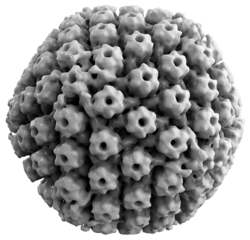Biology:Simplexvirus
| Simplexvirus | |
|---|---|

| |
| 3D computer reconstruction of a Human alphaherpesvirus 1 capsid | |
| Virus classification | |
| (unranked): | Virus |
| Realm: | Duplodnaviria |
| Kingdom: | Heunggongvirae |
| Phylum: | Peploviricota |
| Class: | Herviviricetes |
| Order: | Herpesvirales |
| Family: | Orthoherpesviridae |
| Subfamily: | Alphaherpesvirinae |
| Genus: | Simplexvirus |
| Species | |
|
See text | |
Simplexvirus is a genus of viruses in the order Herpesvirales, in the family Herpesviridae, in the subfamily Alphaherpesvirinae. Humans and mammals serve as natural hosts. Diseases associated with this genus include skin vesicles or mucosal ulcers, rarely encephalitis, and meningitis.[1][2]
Species
The following 17 species are assigned to the genus in ICTV 2022:[2]
- Simplexvirus atelinealpha1
- Simplexvirus bovinealpha2
- Simplexvirus cercopithecinealpha2
- Simplexvirus humanalpha1
- Simplexvirus humanalpha2
- Simplexvirus leporidalpha4
- Simplexvirus macacinealpha1
- Simplexvirus macacinealpha2
- Simplexvirus macacinealpha3
- Simplexvirus macropodidalpha1
- Simplexvirus macropodidalpha2
- Simplexvirus macropodidalpha4
- Simplexvirus paninealpha3
- Simplexvirus papiinealpha2
- Simplexvirus pteropodidalpha1
- Simplexvirus pteropodidalpha2
- Simplexvirus saimiriinealpha1
Structure
Viruses in Simplexvirus are enveloped, with icosahedral, spherical to pleomorphic, and round geometries, and T=16 symmetry. The diameter is around 150-200 nm. Genomes are linear and unsegmented, around 152kb in length.[1]
| Genus | Structure | Symmetry | Capsid | Genomic arrangement | Genomic segmentation |
|---|---|---|---|---|---|
| Simplexvirus | Spherical pleomorphic | T=16 | Enveloped | Linear | Monopartite |
Lifecycle
Viral replication is nuclear, and is lysogenic. Entry into the host cell is achieved by attachment of the viral gB, gC, gD, and gH proteins to host receptors, which mediates endocytosis. Replication follows the dsDNA bidirectional replication model. DNA-templated transcription, with some alternative splicing mechanism, is the method of transcription. Translation takes place by leaky scanning. The virus exits the host cell by nuclear egress, budding, and microtubular outwards viral transport. Human and mammals serve as the natural hosts. Transmission routes are sexual, contact, and saliva.[1]
| Genus | Host details | Tissue tropism | Entry details | Release details | Replication site | Assembly site | Transmission |
|---|---|---|---|---|---|---|---|
| Simplexvirus | Humans; mammals | Epithelial mucosa | Cell receptor endocytosis | Budding | Nucleus | Nucleus | Saliva |
References
- ↑ 1.0 1.1 1.2 "Viral Zone". ExPASy. http://viralzone.expasy.org/all_by_species/178.html. Retrieved 15 June 2015.
- ↑ 2.0 2.1 "Virus Taxonomy: 2022 Release". International Committee on Taxonomy of Viruses (ICTV). March 2023. https://ictv.global/taxonomy.
External links
Wikidata ☰ Q1509095 entry
 |

